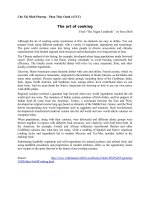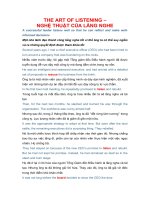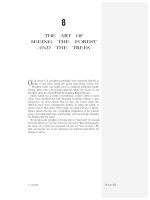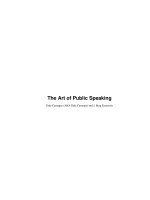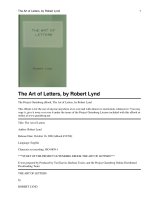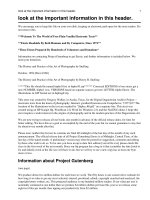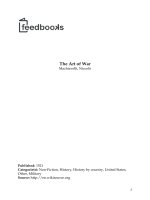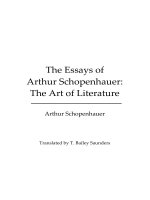- Trang chủ >>
- Mầm non - Tiểu học >>
- Lớp 5
5 3 5 the art of makeup TG
Bạn đang xem bản rút gọn của tài liệu. Xem và tải ngay bản đầy đủ của tài liệu tại đây (126.63 KB, 4 trang )
The Art of Makeup
SUMMARY
Today’s makeup artists can easily
transform a human actor into a fantastic
creature by making masks, false teeth,
or wigs. This book describes the detailed
processes for making these special effects.
LESSON VOCABULARY
background
miniature
reassembled
landscape
prehistoric
INTRODUCE THE BOOK
INTRODUCE THE TITLE AND AUTHOR
Discuss with
students the title and the author of The Art of
Makeup: Going Behind the Mask. Ask students
what kind of makeup they expect to read
about. Ask: How does the cover photo help
reveal what the book will be about?
BUILD BACKGROUND Invite students to discuss
films they’ve seen that have actors wearing
heavy makeup. They may mention the Harry
Potter or the Lord of the Rings series. Ask
students to describe the masks, teeth, or
wigs worn by specific characters. Ask students
if they’ve ever seen a makeup artist at work or
if they know what tricks or techniques makeup
artists use.
PREVIEW/USE TEXT FEATURES
As students
preview the book, have them note how the
chapter heads and subheads indicate how the
information in the book is presented. Have
them note also the kinds of information that
the captions present.
5.3.5
GRAPHIC SOURCES
PRIOR KNOWLEDGE
READ THE BOOK
SET PURPOSE
Have students set a purpose for
reading The Art of Makeup: Going Behind the
Mask. Some students may be curious how the
masks of film creatures are made. Others may
have an interest in becoming makeup artists
or in learning if they can create film makeup
at home to use with friends.
STRATEGY SUPPORT: PRIOR KNOWLEDGE
Remind
students that their prior knowledge also
can help them make sense of the graphic
sources, especially the photos, in this book.
For instance, students who have made
papier-mâché masks know that they can
crack if lower layers are not allowed to dry
before new layers are applied on top. This will
help students understand the mask-making
process described on pages 8–11.
COMPREHENSION QUESTIONS
PAGES 4–6
Name several reasons that makeup
takes so long to apply. (Artists must get every
detail right; substances must set or dry properly;
actor safety—makeup can be dangerous.)
PAGE 8 What is alginate, and how is it used?
(a rubber-like substance that can be sculpted
for masks)
PAGES 10–11 How does the pair of photos help
explain how a mask connects to an actor’s
skin? (It shows the makeup artist using a brush
to smooth the contours of the mask and blend
it in.)
PAGE 15
What is the last step in the creation
of false teeth? (The actor tries them on, and
adjustments are made if the teeth hurt.)
Have students make a Sequence
graphic organizer for each type of makeup
discussed. First, they should write the steps
of the mask-creation process. They can follow
the same procedure for teeth and wigs.
68
The Art of Makeup: Going Behind the Mask
16911_LRD_TG_068-069 68
1/4/06 9:50:54 AM
REVISIT THE BOOK
READER RESPONSE
1. Possible response: They helped explain
each step in the process.
2. Responses will vary.
3. Possible response: It provides the setting
for the action.
4. Possible response: The process is long
and complicated, and it involves some
potentially dangerous materials.
EXTEND UNDERSTANDING
Focus students
on page 15 of the book. Ask: What is the
author trying to show with these two photos?
How does including both photos help us to
understand the teeth-making process better?
Also, invite students to look at the drawing
and inset photo on page 17. Ask: Why did the
author include both of these images?
RESPONSE OPTIONS
WRITING
Have students work in groups to
create a character and describe the special
mask, teeth, and wig it would need. If
possible, ask a student from each group
to draw the character. Then have students
present their group creations to the class.
WORD WORK
The vocabulary for this book
includes two compound words (background
and landscape). Remind students that a
compound word is a single word made of
two words joined together. Ask students to
come up with five additional compound words,
define them, and share several with the
group.
SOCIAL STUDIES
CONNECTION
Have students use the
Internet or library to
research the process, created
during the reign of Louis XVI, of ventilating
to create wigs. Encourage students to
find images to supplement their research.
Students may also enjoy researching famous
makeup artists from the film industry.
Skill Work
TEACH/REVIEW VOCABULARY
Have students define vocabulary words they
know and discuss words they don’t. Note
the two vocabulary words that have prefixes
(prehistoric and reassembled). Define these
prefixes for students (pre- means “before”;
re- means “again”). Invite students to suggest other words with these prefixes.
TARGET SKILL AND STRATEGY
GRAPHIC SOURCES
Remind students
that a graphic source is a way of showing
information visually. Graphics used in this
text include photos with captions. Several of
the photos show steps of a process, such
as the photos on pages 10, 12–13, and 14.
Explain that these two- or three-step photo
diagrams are meant to help students see
the steps of a process in order.
PRIOR KNOWLEDGE
Tell students that prior
knowledge they have obtained from reading
or from life experiences can help them to
understand this book. Any student who has
had braces or who knows someone who
has will know about dental impressions. And
most students will have seen films featuring
heavily made-up actors or actresses. As
they preview the book, students can connect
this prior knowledge with the graphics.
ADDITIONAL SKILL INSTRUCTION
MAIN IDEA Remind students that it is
important to understand the main ideas of
this book so they understand how makeup
artists create masks, false teeth, and wigs.
Then model for students the process of
finding the main idea. First, ask students
to look at particular paragraphs. Then ask:
What is the most important idea about
this topic (the main idea)? Help students
understand that sometimes the main idea
will be implied—that is, not stated outright
in the text.
The Art of Makeup: Going Behind the Mask
16911_LRD_TG_068-069 69
69
1/18/06 10:57:03 AM
Name
The Art of Makeup
Graphic Sources
• Graphic sources include items such as advertisements, charts, diagrams, graphs, maps,
menus, photographs, recipes, and timetables.
• Use graphic sources to help you understand text and to draw conclusions as you read.
Directions Look at the graphic sources throughout The Art of Makeup: Going Behind the Mask.
Then answer the questions below.
1. What type of graphic source is shown on page 17?
2. Review the steps for making a foam latex mask discussed in the text on pages 8–11.
What step or steps are shown in the photos on page 10?
3. Look at pages 12–15. How do the photos shown here work with the text? How do the
arrows help?
4. What is the black-and-white graphic source on page 17?
5. What does the “inset” photograph on page 17 show?
7. List two techniques makeup artists use to create characters.
© Pearson Education 5
6. Did the graphic sources in this book help you understand the text better? Explain.
70
16911_LRD_TG_070-071 1
1/4/06 9:51:15 AM
The Art of Makeup
Name
Vocabulary
Directions Choose the word from the box that best matches each definition.
Write the word on the line.
Check the Words You Know
background
prehistoric
landscape
reassembled
miniature
1.
of or belonging to times before histories were written
2.
the part of a picture or scene behind the subject
3.
done or made on a very small scale; tiny
4.
brought together again
5.
view of scenery on land
Directions Choose the word from the box that best completes each sentence.
Write the word on the line.
6. The makeup artist
7. The makeup artist created a
a larger mask for the actor.
8. The
his tray of makeup after it fell on the floor.
model of the ape before creating
of distant flowers and trees looked very realistic.
9. The character’s makeup looked especially scary set against the
of moldy old dungeon walls.
© Pearson Education 5
10. Artists need to rely on both fossil remains and their imaginations when they try to create makeup
for
cave-dwelling characters.
71
16911_LRD_TG_070-071 2
1/4/06 9:51:16 AM
